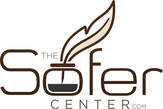What is a Sefer Torah?The Sefer Torah is a long scroll containing the entire text of the Five Books of Moses, hand-written by a pious scribe in the original Hebrew. It is rolled up around two ornate wooden shafts, attached to either end of the scroll.
Kept in the Ark of each synagogue, the Sefer Torah is routinely read aloud in all synagogues, and in its presence we offer prayers and blessings for all those in need. We read from the Torah scroll four times a week, on Shabbos morning, Shabbos afternoon, and on Monday and Thursday mornings. In addition, the Sefer Torah is read on many Jewish festivals, the first day(s) of the new Hebrew month and fast days. Yet the Sefer Torah is much more than that. It is the core representation of Judaism itself. It is the tangible embodiment of our connection to G-d and of His wisdom and guidance. On the most joyous day of the year, we embrace it in our arms, as we dance ecstatically and celebrate that connection. Our holiest and most precious treasure, the Torah is literally G-d’s gift to the world. The Torah is our guide to life. Actually, the Torah is our life. Without it, the Jewish People cannot live. It is the heart, mind and soul of Judaism, right there in front of you, black on white. The original hard copy. The first Sefer Torah in history was dictated by G-d verbatim and written by Moses, just before his passing. In his parting words, he told them to listen to the words found in that scroll and to reference them in response to life’s questions. They taught their children to do the same, and that’s how we’ve kept its tradition until this day. From that Sefer Torah, many identical copies were hand-written by a pious scribe, and likewise in all subsequent generations. Today there are many hundreds of thousands of Sifrei Torah in existence. According to Jewish law, a Sefer Torah (plural: Sifrei Torah) is a copy of the formal Hebrew text of the Five Books of Moses hand-written on parchment by using a quill (or other permitted writing utensil) dipped in ink. Producing a Sefer Torah fulfills one of the 613 Mitzvos (Judaism’s commandments). “The k’laf/parchment on which the Torah is written, the hair or sinew with which the panels of parchment are sewn together, and the quill pen with which the text is written all must come from ritually clean —that is, kosher— animals.” Written entirely in Hebrew, a Sefer Torah contains 304,805 letters, all of which must be duplicated precisely by a trained sofer (“scribe”), an effort which may take as long as approximately one and a half years. The parchment on which the sacred Hebrew text is written is mounted into a wooden housing called עץ חיים (Tree of Life) in Hebrew. The housing has two rollers, each of which has two handles used for scrolling the text, four handles in all. Between the handles and the rollers are round plates or disks which are carved with images of holy places, engraved with dedications to the donor’s parents or other loved ones, and decorated with gold or silver. |
Most modern Sifrei Torah are written with forty-two lines of text per column (Yemenite Jews use fifty).And 245 columns. Very strict rules about the position and appearance of the Hebrew letters are observed. Any of several Hebrew scripts may be used, most of which are fairly ornate and exacting.
Some errors are inevitable in the course of production. If the error involves a word other than the name of God, the mistaken letter may be obliterated from the scroll by scraping the letter off the scroll with a sharp object. If the name of God is written in error, the entire page must be cut from the scroll and a new page added, and the page written anew from the beginning. The new page is sewn into the scroll to maintain continuity of the document. The old page is treated with appropriate respect, and is buried with respect rather than being otherwise destroyed or discrded. The completion of the Sefer Torah is a cause for great celebration, and honored guests of the individual who commissioned the Torah are invited to a celebration wherein each of the honored guests is given the opportunity to write one of the final letters. It is a great honor to be chosen for this. It is a Mitzvah for every Jewish male to either write or have written for him a Sefer Torah. In the Torah’s 613 Mitzvos (commandments) the 613th is that every Jewish male should write a Sefer Torah in their lifetime.(Deut. 31:19) Because of the work involved, these can cost tens of thousands of dollars to produce to ritually proper standards. A printed version of the Torah is known as a Chumash (plural Chumashim). They are treated as respected texts, but not anywhere near the level of sacredness accorded a Sefer Torah, which is often a major possession of a Jewish community. A Chumash contains the Torah and other writings, usually organised for liturgical use, and sometimes accompanied by some of the main classic commentary |
What our clients say about us: |
To enhance our service quality, we operate on an appointment-only basis.
Please contact us to make an appointment. $12.99 Flat rate shipping! Mezuzahs, Tefillin & Accessories! |
|






